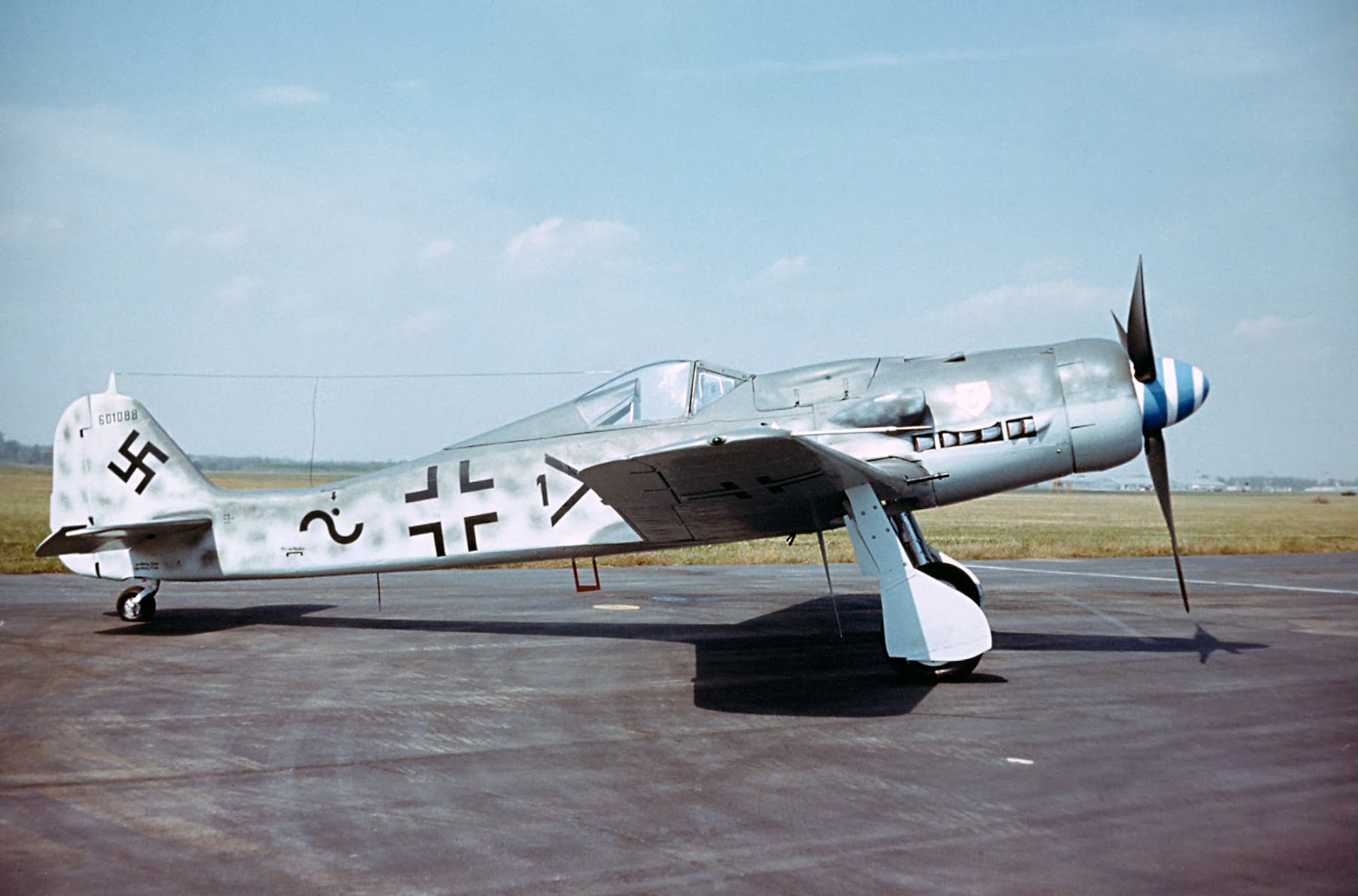Focke Wulf Fw 190
"The Focke-Wulf Fw 190 first fought in World War Two in the summer of 1941. The Focke-Wulf Fw 190 was a highly advanced aircraft for the day and was given the nickname ‘Würger’ – Butcher Bird – in deference for its killing ability. The Focke-Wulf Fw 190 had speed and manoeuvrability as its two great assets.
The Fw 190 was first conceived in 1937 and the first prototype flew on June 1939. The Fw 190 was a small, low-wing monoplane. The aircraft was all-metal with a stressed all-duralumin skin. The undercarriage was wide-tracked, which gave the Fw 190 much greater stability compared to the Me 109 and allowed it to take off and land on runways that other German fighters – such as the Me 109 – would have found difficult.
The first trials of the aircraft were in 1940 and few problems were encountered. The only criticism that the pilots had was that the plane lacked sufficient firepower. The Fw 190 went into production and the first combat model had a top speed of 388 mph from its 1600 hp engine. The first record of combat was with Spitfires in June 1941 when the Fw 190 acquitted itself well though the pilots complained of a lack of firepower. This criticism led to the Mk II version, which had two wing-mounted synchronised 20-mm cannon and two MG 17 guns. The Mk II version had a top speed of 382 mph. This armament and speed made it a match for the Mk V Spitfire that was in service then.
The pilot of a Fw 190 could use all his guns at once or, with the flick of a switch, select pairs of guns independently. He had excellent vision as a result of the design of the cockpit and the Revi C/12D gun sight greatly assisted his targeting. The success rate of a Fw 190 pilot was very good – hence the ‘Butcher Bird’ nickname.
Though the Battle of Britain was over, the Luftwaffe continued with raids on the UK mainland even after the Blitz. Fw 190’s, among others, escorted German bombers. The tactic employed to throw off any chasing RAF fighters on the journey home was to fly at a low altitude. In was while supporting bombers at a low altitude that the Fw 190 met its match in the RAF’s Typhoon. Out of the first sixty kills by Typhoons, forty were Fw 190’s. Fw 190’s also raided southern British ports on their own ‘tip and run’ raids.
Nearly 200 Fw 190’s were used to great effect in the disastrous Allied landing at Dieppe in August 1942. The RAF had no idea that two new versions of the Fw 190 were flying that day – one that operated as a bomber (Fw 190A-3/U1) and another (the Fw 190A-4) that had a top speed of 416 mph.
By the end of 1942, the Fw 190 was fighting in North Africa, the Russian Front and in Western Europe. In Russia, the Fw 190 proved very effective when low flying ground attacks were made against vehicle convoys and tanks. If these convoys were not protected by Russian air cover, the damage done to them could be great. The Fw 190 in Russia carried the SC 250 and SC 500 bombs – both of which could knock out a tank. However, as with all issues on the Russian Front, maintaining supplies for the Fw 190 squadrons was a major problem, especially as many planes flew eight sorties a day. Russian partisans did a great deal to disrupt the movement of German supplies to the front and all aspects of the German fighting machine – including the Luftwaffe – suffered accordingly.
Eventually the Fw 190 had variants that carried torpedoes, bombs, rockets and more powerful gun platforms. The development of the Mk IX Spitfire forced those who designed the Fw 190 to enhance its speed even more. This resulted in the Fw 190D – 9’s which first saw service in September 1944. This variant had a larger nose that housed a more powerful Junkers Jumo engine that produced 1,770 hp. Another version of the Fw 190D was the Ta 152 – the Ta being in recognition of Kurt Tank who had responsibility for the whole Fw 190 design programme. The Ta 152H-1 had a maximum speed of 472 mph at 41,000 feet and was armed with one 30-mm and two 20-mm guns. However, the war ended before this variant could really prove itself in battle.
By the time World War Two ended, 20,087 Fw 190’s had been built. At its peak twenty-two Fw 190’s were being produced each day. A number of German aces – Otto Kittel, Walter Nowotny and Herman Graf among them – made over 100 kills in a Fw 190. When war in Europe ended, the Luftwaffe had 1,612 Fw 190’s of which 809 were ground attack versions."








